Candy Cane Coral: Care, Appearance & Types, Placement & More
Posted by on 2/06/2023
Fact checked by
We use affiliate links and may receive a small commission on purchases.
Candy Cane Corals, also known as Trumpet Corals, are large polyp stony (LPS) corals from the Caulastrea genus and are often pursued by hobbyists for their affordability, ease of care, and circular shaped polyps that are found in a variety of colors.
These fast-growing corals make an excellent option for hobbyists new to reef keeping, or for experienced hobbyists looking to add an interesting piece to their coral collection. Before choosing a coral, it's important to have a thorough understanding of its care requirements. In this post, we're going to discuss candy cane coral care, the different color morphs that are often traded in the hobby, and much more.
Table of Contents
January's Giveaways on Light Fish
Species Summary
Candy Cane Coral (scientific name: Caulastraea) is a genus of stony corals, also referred to as Trumpet Coral. These corals fall under the Merulinidae family, which contains other popular genera such as Trachyphyllia and Favites.
Hobbyists should be aware that there is some confusion regarding the names of these corals. Many hobbyists and vendors will use the name Candy Cane Coral and Trumpet Coral interchangeably, while others refer to only a specific species, Caulastraea furcata as a Candy Cane Coral and Caulastraea echinulata as a Trumpet Coral.
These corals are native to the Indo-Pacific and were first scientifically classified in 1846, by American zoologist James Dwight Dana .

Size
In their native habitat, Candy Cane Coral colonies can be multiple feet in diameter, but corals sold to hobbyists will be much smaller, typically only a few inches in size. Candy Cane Polyps can be quite small, with some polyps being only half an inch in diameter.
Vendors will often sell small frags at about 1-2 inches in diameter, and frags considered to be large will be about 3-4 inches in diameter.
Growth Rate
Candy Cane Corals are fast-growing, and when given proper conditions, can grow up to a ¼" per month.
Providing a pristine environment and direct feeding twice a week can result in the fastest growth rates seen in these corals. It's not unrealistic to go from 1 polyp to 20 in a year.
Appearance & Types
Candy Cane Corals showcase some of the brightest neons seen in the hobby under actinic lighting. Combined with their ease of care, they offer a lot to beginners looking to purchase brightly colored and affordable coral.
Some color morphs are more common than others. Neon greens tend to be a bit more common and affordable, while dark blues and purples fetch a higher price tag due to their rarity.
Neon Green Candy Cane Coral
One of the most common color morphs, the Neon Green Candy Cane Coral is an affordable Caulastraea color morph that is often recommended for beginners.
Priced between $10-30 for a ¾"-sized coral, the lime green coloration makes a great addition to any reef tank.
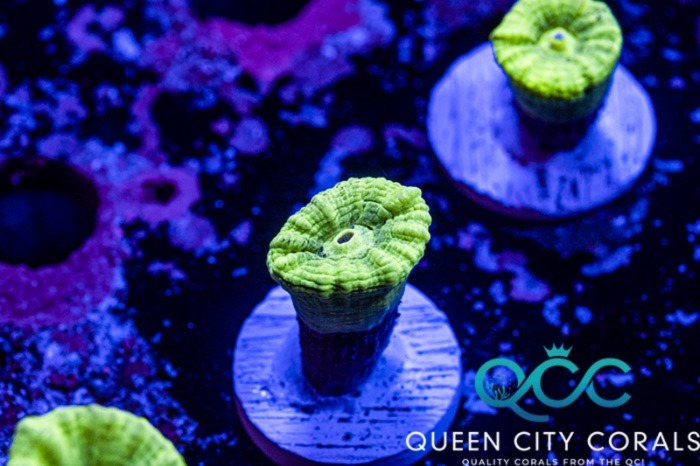
Green Candy Cane Coral
Similar to the Neon Green Candy Cane, the Green Candy Cane showcases a darker green coloration and is still as affordable and easy to take care of as the Neon Green color morph.
Prices range from $15-30 for a ¾" sized coral.
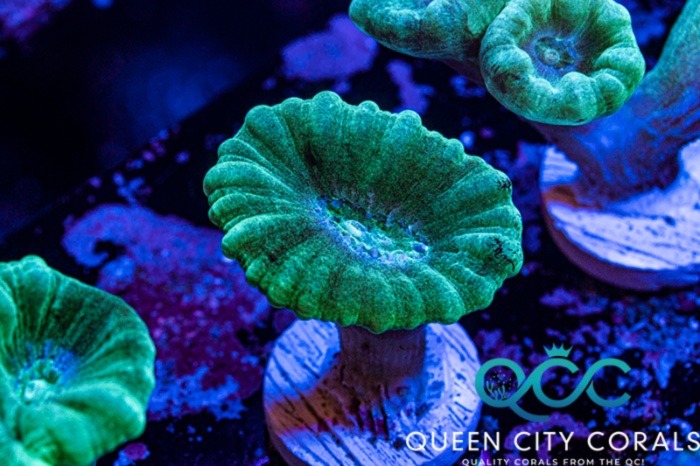
Turquoise Candy Cane Coral
Next on our list is the Turquoise Candy Cane. Similar to the Neon Green Candy Cane, the Turquoise Candy Cane is an affordable color morph that looks great in a home aquarium.
Small ¾" frags can go for $10-30.
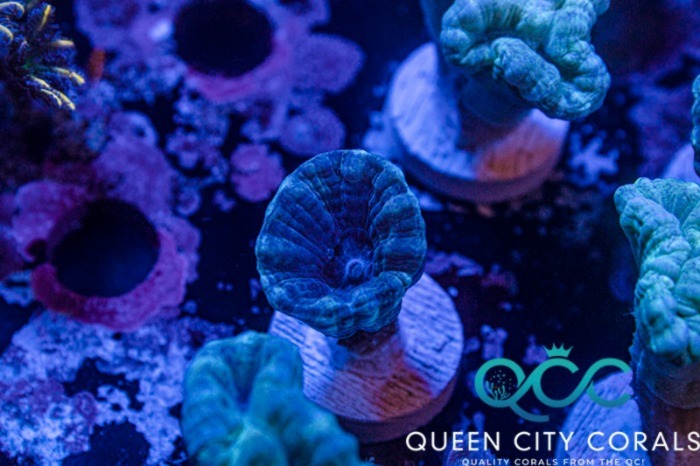
Purple Candy Cane Coral
If you're looking for a rare color morph, look no further than the Purple Candy Cane. Known for its neon green mouth surrounded by purple ridges, this coral is a bit pricier than the neon green and turquoise color morphs but is still somewhat affordable.
Hobbyists can expect to see prices between $25-50 for a Purple Candy Cane Coral.
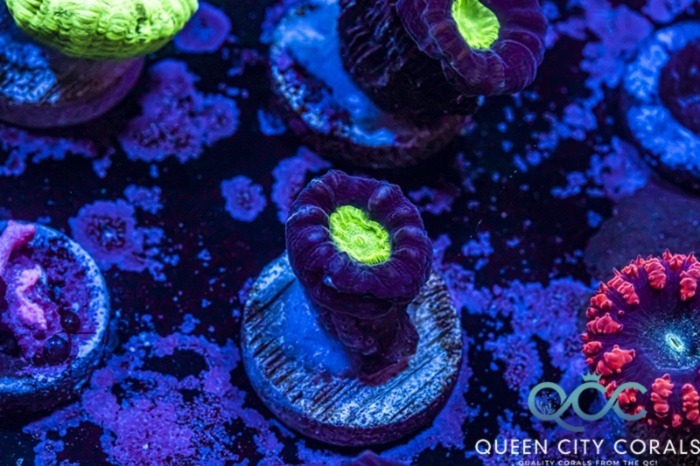
Blue Candy Cane Coral
Similar to the Purple Candy Cane Coral, the Blue Candy Cane Coral is a rare color morph resulting in a higher price tag.
A 1-head frag can sell for anywhere between $30-$50.
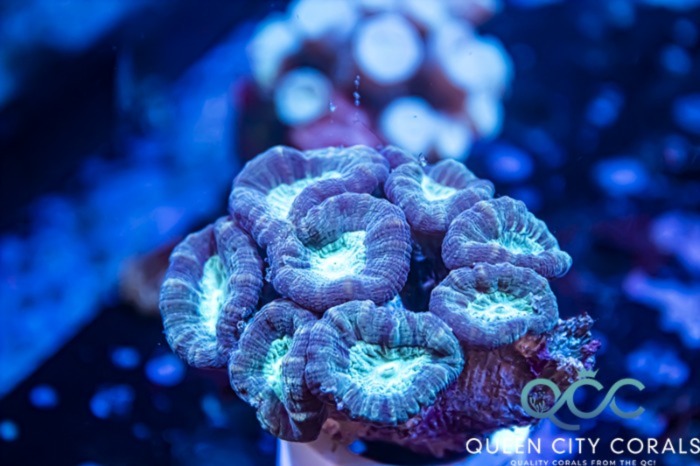
Candy Cane Coral Care
Candy Cane Corals have a reputation for being the easiest to care for LPS (large polyp stony) coral species. Their tolerance for subtle increases in nitrate makes them great corals for beginners new to reef keeping.
If you're considering adding one of these to your reef tank, you'll want to be aware of their care requirements.
Tank Size
Candy Cane Corals should be kept in an aquarium that's at least 75 gallons in size.
Okay, technically they'll do well in an aquarium of any size. BUT - having a larger tank means more stable water parameters. If you're new to reef keeping, having a larger tank will make your life a bit easier, and give you plenty of extra space if you plan on adding additional coral with sweeper tentacles.
However, if you're experienced and up for the challenge of a nano tank, go with whatever size you'd like for a Candy Cane Coral.
Water Parameters
Candy Cane Corals can tolerate small increases in nitrates and phosphates and small decreases in alkalinity and calcium. As with all corals, you'll still want to provide the most optimal environment possible.
You'll want to maintain the following water parameters:
Salinity: 1.023 - 1.025
dKH: 8-12
pH: 8.1-8.4
Nitrate: 1-10ppm
Phosphate: 0.01-0.05ppm
Calcium: 380-450ppm
Keeping these parameters stable will give you the best chance of success when keeping Candy Canes.
Tank Setup
It's important to carefully plan your tank layout ahead of time so that you won't run into any territorial disputes when it comes to keeping different types of coral species.
You'll need adequate lighting, proper flow, and correct placement to recreate the natural habitat of Caulastrea corals.
Placement
Candy Cane Corals can be placed almost anywhere in a reef tank, as long as they're not too close to any neighboring corals and can receive moderate flow and lighting. Some placement options include the bottom of the tank on the sand bed or attached to a rock.
Although they don't present themselves as frequently compared to other corals, candy cane corals do have stinging tentacles that can extend about 2 inches in length and attack neighboring corals. Keep this in mind when deciding on a location for your candy cane coral.
Lighting
Candy Cane Corals can adapt to a wide range of light intensity. These corals can grow in low light environments (50-70 PAR) but can also adapt to more moderate and high light (150+ PAR) conditions.
If you're planning on exposing these corals to higher light intensities, be sure to acclimate these corals over 2 weeks to prevent bleaching .
Flow
While Candy Canes can adapt to higher flow rates, they'll show off their inflated appearance when kept in areas with low to moderate flow rates.
Aim for just enough flow so that detritus and other material in the tank do not accumulate on the flesh of the coral. An adjustable powerhead can be used to dial in the correct amount of flow.
Feeding
We recommend directly feeding Candy Cane Corals at least 2-3 times per week.
Candy Cane Corals are aggressive feeders, and they'll use their tentacles to catch and consume potential food sources. Mysis shrimp, krill, pellets, and liquid solutions such as Reef Roids can be directly fed to these corals.
While Candy Canes, similar to other LPS species, have a symbiotic relationship with Zooxanthellae, they'll show off their best appearance and growth rates when supplemented with direct feeding.
Behavior
Although not as aggressive as other coral species, such as torches, Candy Cane Corals do have sweeper tentacles and will attack neighboring corals.
Luckily, candy cane corals will not attack their own species, so you can place different candy cane colonies next to each other, creating colorful coral displays.
Fragging
One of the best parts about owning a Candy Cane Coral is that they are incredibly easy to frag. Using a pair of sharp pliers, all you need to do is cut through their stalks.
If you're having trouble using pliers, a dremel or band saw can be used.
After fragging, you can glue the stalk to a frag plug, and place the coral on a frag rack or place it along the sandbed or rock in your display tank.
Tank Mates
As long as your tank is large enough, you'll have plenty of interesting tank mate options for these corals.
Some of our favorite corals to be kept in an aquarium that houses candy canes, include blastos, leather corals, brain corals, chalices, and torches.
Avoid anemones, such as the black widow as these invertebrates are capable of moving around the tank and stinging your candy canes.
If you're looking for livestock suggestions, you can't go wrong with the following:
- Snowflake Clownfish
- Blue Chromis
- Pink Skunk Clownfish
- Blonde Naso Tang
- Cleaner Shrimp
- Orange Spotted Goby
Avoid butterflyfish and angelfish, as these fish will pick at and eat corals. Larger, aggressive fish such as the Tessalata Eel should also be avoided, as they can easily knock over and damage coral.
Conclusion
Candy Cane Corals are some of the best corals in the reef keeping hobby. They're affordable, brightly colored, and easy to keep. It's no wonder that they're some of the best options for beginners. Even experienced hobbyists will appreciate their fast growth and ease of propagation.
Do you plan on adding one of these corals to your reef tank? Let us know by commenting below, and be sure to check out our marketplace where these corals are occasionally sold, and our community forum where you can connect with other hobbyists.
January's Giveaways on Light Fish


